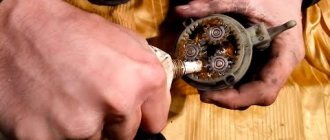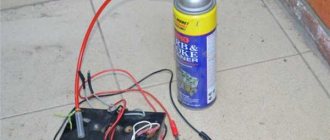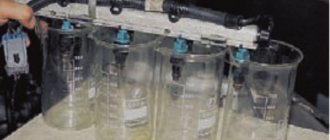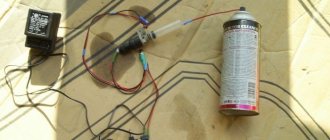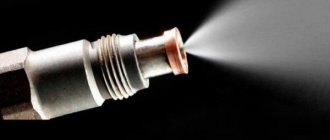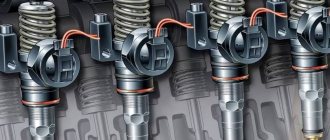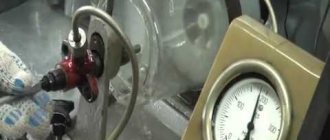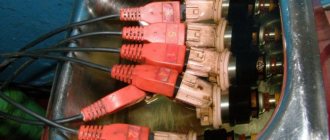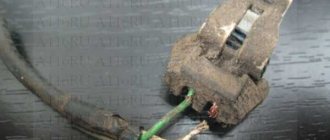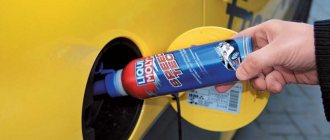Periodic cleaning of the fuel system becomes mandatory after using the car for several years. The use of ultrasound and other industrial means is the only way out of this situation.
Today we’ll look at options for how to clean the injector and injectors yourself, using various substances and tools.
How to clean injectors yourself
Today we will offer four ways to clean the fuel system of a gasoline engine.
They look like this:
- Using carburetor cleaner.
- Application of a flushing cylinder.
- Adding acetone to gasoline through the fuel tank.
- Using Dimexide in the process.
Each of the listed methods has features and rules that should be followed when using the options. Because of this, all paths are considered separately, with consideration of the procedure.
Pros and cons of cleaning yourself
The first argument in favor is savings. Some car enthusiasts save money and do not go to the service station. Clean the injectors yourself. This is an acceptable option when it comes to older engines, where the intake system does not depend much on the central control unit of the car. In addition, it is important to consider the mechanic’s experience. If a person disassembles and maintains an engine for the first time, there is a high probability that he will not cope with the task.
The second advantage is the objectivity of the assessment. You will certainly know the exact status of your fuel system. No mechanic at a service station or mechanic at a dealership can deceive you. Self-cleaning will show the true picture of what is happening. However, you will need to master minimal skills in car repair.
The main disadvantage is the impossibility of washing to an “ideal” state. No cleaning method at home will give you the same quality as professional equipment in a specialized service station.
Carburetor cleaner
Fuel system cleaner for carburetors becomes a tool that can help quickly clean injectors. First you need to collect a small list of tools, then proceed to the main steps.
Since the procedure will be carried out with the element removed, it will need to be connected to something that will be able to open the nozzle. This item is included in the list of tools needed to implement this method:
- Electrical tape, battery, cable.
- Liquid for flushing the carburetor fuel system of a gasoline engine.
- A small piece of oxygen hose, an awl.
Some of the listed items can be replaced with others that can perform the functions specified in the instructions.
To clean the injectors with carburetor cleaner, simply follow these steps:
- Removing the nozzle and cleaning its outer part using a soft brush or brush.
- The prepared cable is cut into two equal parts and the insulation is removed from one side on each resulting wire.
- Connecting the wires to the battery and wrapping them using electrical tape.
- Cutting an adapter from a rubber hose, then connecting the cap of the fuel system cleaner, the adapter and the injector.
- Connect the wires from the battery to the contacts on the injector so that it opens.
- Press the cap of the cleaner and gradually clean the injectors.
It is important to put on plastic glasses before pressing on the carburetor cleaner cap. The jet will be strong enough to cause splashes. The solution may get into your eyes, causing irritation and other consequences.
For cooling system
Vehicle owners rarely consider flushing the cooling system a priority. But its clogging is fraught with a long list of problems:
- pump breakdown;
- radiator failure;
- periodic engine overheating;
- improper operation of the stove.
And this is just a sample list! In each specific case, it is worth contacting the experts. They will determine the level of contamination in the system and suggest the best cleaning method.
Important! Professionals recommend cleaning the system every time you replace antifreeze. The maximum possible period of operation of a vehicle without cleaning is 3 years.
Kuhler-Reiniger
Kuhler-Reiniger injector cleaner from Liqui Moly
A simple and effective product that every driver can afford. It is universal, so it can easily cope with almost all contaminants:
- lime;
- corrosion;
- oil;
- fatty traces.
The composition is used according to the standard scheme:
- antifreeze drain;
- filling the system with cleaning composition;
- run through all nodes;
- drain
Advantages and disadvantages
affordability
neutralization of all deposits
removal of up to 98% of contaminants after the first rinse
it is difficult to find in retail outlets
The price of washing is about 250 rubles.
CRC Radiator Clean
Radiator Clean cleaner from CRC
A high-quality, effective and affordable product, widely used on the market. Its main purpose is to remove scale. The composition is effective after pouring into the system and working for a short time. After cleaning and draining the liquid, you can refill the antifreeze.
Peculiarities:
- rich composition (surfactants, substances that prevent rust, components that neutralize acids);
- ability to remove oily deposits.
Advantages and disadvantages
high performance
budget
he quickly understands the stores
The cost of packaging does not exceed 350 rubles.
Hi-Gear HG9014/9017
Product Hi-Gear HG9014/9017
The product belongs to the fast-acting group - only seven minutes are enough to flush the system. It copes with any dirt, including oil and grease deposits.
Key Features:
- is the prevention of temperature failures in the system;
- reduction of wear of all components and elements;
- improvement in performance indicators by ½.
Advantages and disadvantages
concentration
restoring normal system operation
oil seal protection
preventing rust
high price
It is available in stores for 450-600 rubles.
Liqui Moli Kuhler Reiniger
Liqui Moli Kuhler Reiniger affordable product
Not the simplest and most affordable product. The manufacturer positions it as universal and suitable for prevention.
The composition acts on all types of deposits and is applied according to the standard scheme. The features of the product include a unique composition - despite all the effectiveness, the formula contains neither alkalis nor acids with increased aggressiveness.
Advantages and disadvantages
neutralization of any types of contaminants
good composition
safety
high price
Availability mainly at online outlets
The cost of the product exceeds 500 rubles.
Flushing cylinder
This method can be used on the street or in the garage, and in the process you will need to make a structure with which the cleaning procedure will take place.
Items and tools used in the variant form the following list:
- A pair of nipples, a hose to match their diameter and a compressor.
- Liquid for flushing the injector or nozzles.
- Two liter bottle.
- Awl or knife, wire, fuel filter.
Here you need to use liquid for washing injectors through a simple homemade device.
The process of constructing it and cleaning the parts consists of several steps, which look like this:
- A plastic bottle is drilled in two places - the bottom and the cap.
- A nipple with a built-in valve is screwed into the bottom of the bottle. A nipple should be installed in the upper part, but without a valve.
- A small piece of hose is attached to the cover, which connects to the hose from the fuel filter.
- Start the engine, remove the connector from the fuel line, and connect it to the fuel pump.
- Removing the hose through which fuel flows to the injectors.
- Pour the cleaning liquid into a bottle and hang it over the hood using a wire or rope.
- Pumping a pressure of three atmospheres into the bottle through a nipple that was installed in its lower part. An electric compressor or pump is used for this.
The last step is to start the car engine for about fifteen minutes, and then turn it off for the same period.
Now you need to start the engine again, but leave it in this state until the injector cleaner for gasoline engines has completely flowed out of the bottle. All you have to do is gradually unscrew the cap from the bottle so that the pressure in it returns to normal.
Mechanical cleaning
This method was relevant until the mid-90s, when car engines were not so capricious. Its essence is to flush the removed injector using the car battery. To do this, you will need to unscrew all the injectors and assess the degree of contamination.
Then you need to take the battery, two wires with terminals and a cleaning agent in a bottle. At the beginning of the process, connect one end of the wire to the battery, and plug the other end into the injector connector. Another wire needs to be hooked onto the outlet part of the nozzle, and the free end should be left dangling.
Now you need to connect the bottle with cleaning fluid to the inlet. Next, you need to start spraying while simultaneously shorting the free end of the wire. Inside the nozzle, the solenoid valve will operate (to open), and the liquid will pass through the part.
Acetone in the fuel tank
There is a lot of controversy surrounding the use of acetone as a means to clean injectors. But this substance definitely has several functions that it performs if you mix it with gasoline in a car tank:
- Increase in octane. Since the octane number indicated in the table at a gas station does not always coincide with reality, acetone becomes an element that acts not only as an injector cleaner, but also as a substance that can increase the octane number to the minimum required by the engine.
- Cleansing effect. If you add acetone to the fuel, a passive cleaning procedure begins in the fuel system. The driver does not have to remove any parts or make fixtures, but the substance independently removes hydrocarbons from the system and also thickens the water that the manufacturer adds to the fuel. Substances that can disrupt the operation of the fuel system are released in the exhaust gases.
These two effects can only bring results if the conditions for working with acetone are followed correctly. Violation of fairly important rules will lead to gradual wear of the engine, and motorists need not to reduce, but to increase its service life. These conditions look like this:
- Octane number. Any engine is designed for an octane range within which it can operate without unnecessary wear and other difficulties. Therefore, you should not exceed the specified octane range.
- Fuel dilution. The average is approximately fifty milliliters of acetone per ten liters of gasoline. If the fuel system is severely clogged, you can gradually increase the indicator to one hundred milliliters.
- Frequency of additions. You can pour acetone into the fuel tank on a regular basis, but you must observe the proportions of adding the substance.
- Manufacturers' recommendations. Manufacturers of fuel and car parts rarely give negative comments on how to clean injectors and whether acetone can be used for this.
Cleaning the injector with acetone is a safe and effective process, but only if you take into account the characteristics of the car and all the substances that are added to the fuel tank.
Stages of injector clogging
In order to promptly respond to clogged injectors, it is important to understand what stages of their clogging exist and when measures should be taken. There are 3 main stages of injector clogging:
- Small. At this stage, the injector performance decreases by only 5–7% and the driver may not even notice it. In this case, the engine usually runs smoothly, but gasoline consumption may increase slightly.
- Average. At this stage, fuel consumption is already noticeably increasing; at idle speed the engine may throttle, and acceleration dynamics are deteriorating. This stage is characterized by a decrease in injector performance by 10–15%. There will be a strong acrid smell from the exhaust pipe.
- Critical. At this stage, the engine will noticeably jerk, strong popping noises will be heard when you press the gas, and injector performance will drop by 20–50%.
If you notice any of the problems listed above, then it’s time to flush the injector. The sooner the procedure is performed, the better. There is no need to wait until the critical stage of contamination. It is optimal to carry out cleaning activities at the stage of medium clogging.
Soaking in dimexide
Dimexide has the property of cleaning objects from hydrocarbons and oils, and the drug is purchased at the pharmacy. The implementation of this option is quite simple: you need to remove the ramp with the injectors, then disassemble it into parts.
Dimexide is poured into a wide-necked canister or other container. Now you need to lower all the ramp parts into the canister and leave them there for ten or twenty minutes.
The process is completed by wiping the elements with dry towels and installing the spare parts in place.
What do Internet users think about gasoline additives for cleaning injector nozzles?
- Doesn't boost, but cleans “Castrol TBE has already been mentioned here. A 180 ml bottle will be enough to treat approximately 5 tanks (250 liters). Actively fights detonation and cleans the engine. An acquaintance who drove a Subaru Forester appreciated its turbo engine. Although the engine speed does not increase, the engine runs smoother and cleaner, and pulls more confidently. Although, maybe this is self-hypnosis.”
Top brands
Chevron
Originally called the Pacific Coast Oil Company, Chevron began operations in 1879.
Since then it has grown into one of the largest oil companies in the world. Techron is one of the best tank injector flushes.
Red Line
Red Line Synthetic Oil began creating lubricants for the racing industry in 1979.
Since then, the Californian company has become synonymous with motorsports and the production of high-quality products. The Red Line Fuel Purification System (60103) Complete SI-1 is our best-selling product.
Royal Purple
Royal Purple is a Texas company known for its petroleum products.
Formulators have been working for over 200 years developing high-performance lubricants. They offer an excellent fuel system cleaner and stabilizer called Royal Purple Max-Clean 11722.
STP Oil
STP Oil was founded in St. Joseph, Missouri.
Since 1954, the company has been producing oils and additives. They gained national fame by sponsoring Nascar legend Richard Petty in the 1970s. The company offers an excellent tank injector cleaner.
